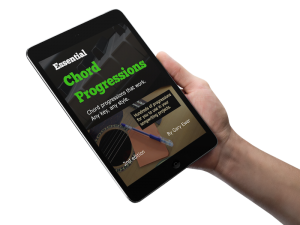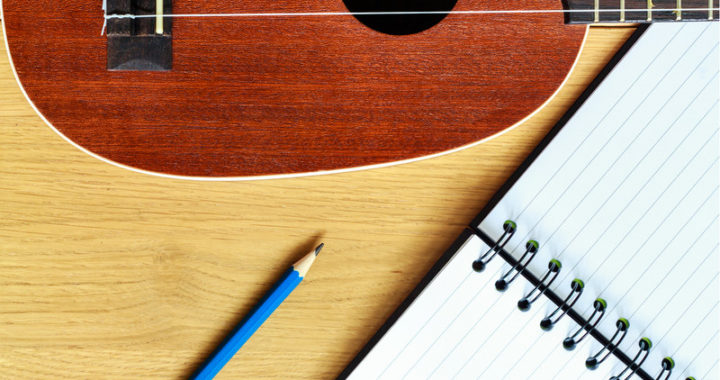Chord progressions are responsible for much of the mood that we pick up in a song. Chords don’t do it on their own of course, but we get a clearer picture of the mood from the way the chords change more than from pretty much any other single element.
Simple, standard progressions work just fine in most songs. For any given key there is a mixture of major and minor chords to choose from, and those choices are usually enough to pull our feelings in one direction to another.
 “The Essential Secrets of Songwriting” eBook bundle includes “Writing a Song From a Chord Progression”. Discover the secrets to writing songs that start with getting a chord progression working.
“The Essential Secrets of Songwriting” eBook bundle includes “Writing a Song From a Chord Progression”. Discover the secrets to writing songs that start with getting a chord progression working.
It’s easy to understand why songwriters spend time looking for unique chord progressions, ones that stray from the norm. It’s because they want to create a unique emotional experience for their fans, and the thought is that a unique, more complex progression will do it.
In that regard, you might be pleased to know that there are ways to manipulate those standard progressions, making them more interesting. The advantage of manipulating a standard progression (rather than trying to create something more complex) is that we know that standard progressions work. All you need are ways to make small changes to a standard progression that leaves all of the benefits in place.
So try some of these ideas if you’ve got a chord progression that works, but just lacks a bit of freshness or imaginative flair:
1. Invert some of the chords.
Normally, when you play a chord, the letter name of the chord is the lowest-sounding note. So for example, when you play A7, your bass player will be playing A. That’s called root position. A chord inversion is one where the root of the chord is not the bass note.
So try some experimenting: place a note other than the root in the bass (or left hand of the keyboard). You probably know these as slash chords, because that’s how they’re notated: the letter before the slash is the chord, and the note after the slash is the bass note: C/E means play a C chord, but play E as your lowest note.
So here’s a standard progression you might see a lot: C F G7 Am
If you assume that you’re going to strum each of those chords for four beats, you could insert some inverted chords, strumming each one for two beats: C C/E F F/A G7 G7/B C
Read more about chord inversions.
2. Use chord suspensions.
Every chord has a root, third and fifth (a C chord is C-E-G…1-3-5). Certain chords can sound more interesting if you lift the third of the chord so that it’s actually playing a 4th above the root. It’s shown with a small ‘sus4’ after the chord.
A Csus4 would move the E of the chord upward, so that you get these three notes: C-F-G. You then usually need to resolve that suspension to its normal triad (C-E-G) before moving on.
So that standard C-F-G7-C progression can sound a bit more interesting if you create a suspension on the G7: C F G7sus4 G7 C. (G7sus4 uses the notes G-C-D-F).
3. Use a modal mixture (or ‘borrowed’) chord.
A modal mixture simply means that, if your song is in a major key, you’re using a chord that borrows the form normally found in the equivalent minor key.
You often see modal mixtures on the IV-chord (the ‘F’ chord in our example progression). And it’s typical (though not absolutely necessary) that you would play the IV-chord first, then the modal mixture minor-iv chord), before moving on, like this: C F Fm G7 C.
There are other interesting modal mixtures. In C major, try Ddim instead of Dm, Ab instead of Am, and Gm instead of G.
Read more about modal mixtures.
4. Try a bass pedal point.
This is an easy change, but you’ll love what it does for your chords. Play through the sample progression, but keep the bass note of the first chord (in our sample, the C chord) in the bass for all the chords.
That’s called a “tonic pedal”, because the C chord is the tonic chord (the one that represents the key of the progression.) Tonic pedals are most common, but you can also get good use out of a “dominant pedal”, which keeps the bass note of the V7 chord (the G7 in this case) in the bass.
It’s up to you how much to use a bass pedal point. You could keep it for part of the progresion (C F/C G7 C), or for the entire progression (C F/C G7/C C).
Read more about bass pedal point.
5. Use a deceptive cadence.
In music the cadence refers to the end of a phrase. In a short progression like our sample one, the cadence is the end of it (G7 moving to C).
A deceptive cadence is one that, instead of giving us the chord we expect at the end, gives us something different. For example, instead of ending the progression G7-C, a common “deception” is to end it on Am, so you get: C F G7 Am.
But really, it’s completely up to you what you choose as your deceptive cadence. You could try ending on a IV-chord (C F G7 F), or even try a flat-VI (C F G7 Ab). Whichever chord you choose, the likelihood is that you’ll want to then continue the progression, and so for that reason, deceptive cadences are a good way to make your progression longer, and perhaps take your song into a new key area.
Read more about deceptive cadences.
 Written by Gary Ewer. Follow Gary on Twitter.
Written by Gary Ewer. Follow Gary on Twitter.
 Looking for lists of progressions you can use in your own songs? “The Essential Secrets of Songwriting” eBook Bundle has 2 main collections, plus eBooks on how to harmonize your own melodies, and more.
Looking for lists of progressions you can use in your own songs? “The Essential Secrets of Songwriting” eBook Bundle has 2 main collections, plus eBooks on how to harmonize your own melodies, and more.










